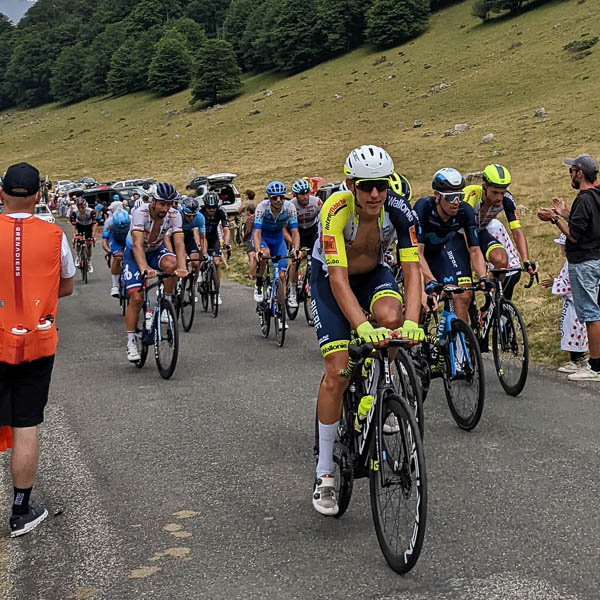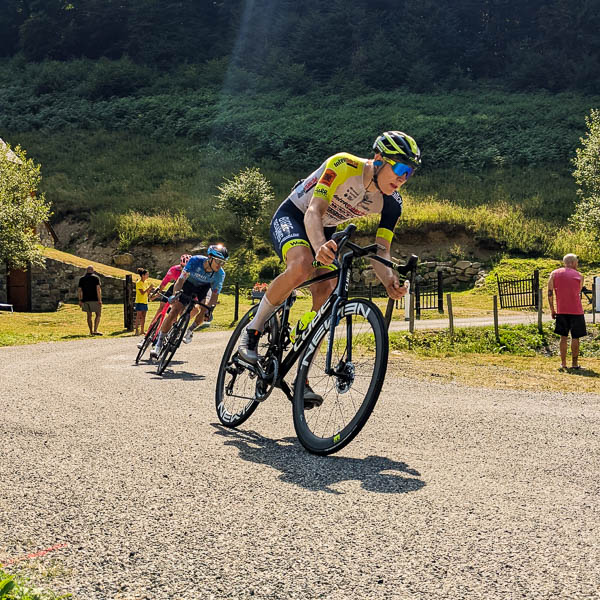Mountain stages of the 2023 Tour de France
Post last updated:
This page showcases all the mountains and climbs for the 2023 Tour de France. The route was announced on 27 October 2022 and promises plenty of action in the mountains once again. This page reflects the information currently available and will be updated periodically as more information is released about the race.
I have been lucky to experience the thrill of watching the Tour de France on multiple mountain stages and am looking forward to 2023. My toughest descision will be which mountain to choose to spectate. In the Pyrenees the 2023 race returns to the slopes of the iconic Col du Tourmalet, while the race returns to the slopes of Le Puy de Dôme for the first time since 1988.
In 2023 the riders will be faced with the mountains in the first week when the hit the Pyrenees. It will be interesting to see how this shapes the race given there will still be a long way to the finish line. This year also sees a mountain stage on the day before the finish which will test the strength and resolve of all the riders before the final stage in Paris the following day. It will be interesting to see it all play out and I can’t wait until July.


If you are considering visiting France for a cycling holiday or to watch the Tour de France, be sure to check out the rest of the Seek Travel ride website. There is a wealth of information to help you plan your cycling holiday to France including lots of practical information, destination guides and travel information. Our Tour de France section includes a general guide to the race each year as well as tips for watching the event roadside.
A brief history of the mountains in the Tour de France
In most editions of the Tour de France, the mountain stages are where the race is won or lost. A single bad day for a rider in the mountains can see them lose minutes to rivals and an end to their title bid. On long mountain climbs, there is nowhere to hide and any little chinks in a rider’s armor are usually found. Over the years climbs such as Alpe d’Huez, Col du Galibier, Mont Ventoux, Col du Tourmalet, and Col d’Aubisque have become synonymous with the race.
The mountain stages are some of the most popular for people to watch the race and there are many iconic images of riders navigating a sea of spectators. It is estimated that many hundreds of thousands of fans line the mountain roads as they twist and turn their way to the summit. On rare occasions, fans get a little too close and bring a rider down.
First mountain stage in the Pyrenees
The mountains first entered the Tour de France in the 8th edition in 1910. In that year stage 10 started in the Pyrenean town of Bagneres de Luchon and climbed Col du Peyresourde, Col d’Aspin, Col du Tourmalet, and Col d’Aubisque before finishing 326km later in Bayon. Octave Lapize finished the stage first in a time of 14hrs 10mins. No mean feat given that all the mountain passes were dirt roads back in those days and the bikes had nowhere near the range of gears modern bikes now have.
Inclusion of the French Alps
While the organizers deemed the addition of the mountains to be successful the riders were less impressed and there were protests in 1910 about the stage. Nevertheless, in 1911 the French Alps were added to the race with the inclusion of Col du Galibier, Col de Castillion, and Col de Braus. This was in addition to the stage in the Pyrenees.
Since those early days, both the Pyrenees and French Alps have featured in the race annually. In later years climbs in other regions such as the Jura, the Vosges, and the Massif Central have been added to the race. The Pyrenees and French Alps have generally taken turns in being featured in the all-important last week of the race.
Famous climbs and the 2023 Tour de France
There are a number of iconic climbs from the Tour de France that everyone loves seeing in the race. Unfortunately they don’t all make it in every year but we thought I would go through and let you know which ones made the 2023 race and which did not.
Climbs in the French Alps
Alpe d’Huez will not feature in the 2023 Tour de France and was last included in 2022.
Col du Galibier, like Alpe d’Huez featured in the 2022 Tour de France and will not be back in 2023.
Col d’Izoard has not been included in the Tour de France since 2019 and again misses out in the 2023 Tour de France.
Mont Ventoux was climbed twice in the 2021 Tour de France and is not included in the 2023 race.
Climbs in the Pyrenees
Col du Tourmalet, the most climbed mountain in Tour de France history, will once again feature in the 2023 Tour de France. It’s going to be a busy year for the mountains with 3 grand tours, Tour de France, Tour de France Femmes and Vuelta a Espana, all using the mountain for stages.
The Col d’Aspin is also back for the 2023 Tour de France and will be the warm up act before the riders head up the Col du Tourmalet. It was also used in the 2022 Tour de France.
The Col d’Aubisqe last appeared in the 2022 Tour de France and is not included in the 2023 race.


2023 Tour de France climb stats
The 2023 Tour de France includes 10 stages with categorized climbs, four of which includes a summit finish; Stage 6 Cauterest-Cambasque, Stage 9 Puy de Dome, Stage 13 Grand Colombier, and Stage 15 Saint Gervais Mont Blanc. Stage 20, the second last stage, packs a punch with 5 categorized climbs. No doubt there will be plenty of tired legs come to this stage. The race in 2023 visits 5 of France’s mountain ranges, the Pyrenees, Massif Central, the Jura, the Alps, and the Vosges.
There are only 2 climbs over 2,000m in the 2023 Tour de France with the highest being Col de la Loze at 2,304m, followed by Col du Tourmalet at 2,115m. Col de la Loze is also the longest climb of the 2023 Tour de France at 28.4km in length. The shortest climb for this edition of the race is the first categorized climb, Côte de Pike, which averages 10% for 2km on stage 1.
ASO, who runs the Tour de France, has now released the full details of each stage. This includes maps, mountain categorisation and estimated time along the course. I have now updated the table to reflect this information and help you plan your own viewing of these mountain stages.
| Stage | Climb | Climb start from stage start (km) | Stage distance (km) | Climb distance (km) | Average gradient | Elevation at top (m) | Comments | Tour de France appearances prior to 2023 | |||
|---|---|---|---|---|---|---|---|---|---|---|---|
| 1 | Côte de Pike | Cat. 3 | 171 | 182 | 2 | 10.00% | 212 | 17:01 - 17:27 | A short but steep climb that averages over 15% towards the end. | Unknown | |
| 2 | Jaizkibel | Cat. 2 | 184 | 209 | 8 | 5.40% | 455 | 16:41 - 17:06 | Unknown | ||
| 5 | Col de Soudet | Hors Category | 73 | 165 | 15 | 7.20% | 1540 | 15:39 - 15:56 | 8 | ||
| 5 | Col de Marie Blanque | Cat. 1 | 139 | 165 | 7.7 | 8.60% | 1035 | 17:02 - 17:30 | 15 | ||
| 6 | Col d'Aspin | Cat. 1 | 56 | 145 | 12 | 6.50% | 1490 | 15:10 - 15:22 | 71 | ||
| 6 | Col du Tourmalet | Hors Category | 81 | 145 | 17.1 | 7.30% | 2115 | 15:55 - 16:13 | 89 | ||
| 6 | Cauterets Cambasque | Cat. 1 | 128 | 145 | 16 | 5.40% | 1355 | 17:08 - 17:33 | 1 | ||
| 9 | Puy de Dôme | Hors Category | 171 | 184 | 13 | 7.70% | 1415 | 18:05 - 18:33 | 13 | ||
| 13 | Grand Colombier | Hors Category | 121 | 138 | 17.4 | 7.10% | 1501 | 17:12 - 17:32 | 23 | ||
| 14 | Col de Cou | Cat. 1 | 28 | 152 | 7 | 7.40% | 1116 | 14:19 - 14:27 | 5 | ||
| 14 | Col du Feu | Cat. 1 | 46 | 152 | 5.8 | 7.80% | 1117 | 14:45 - 14:57 | Unknown | ||
| 14 | Col de la Ramaz | Cat. 1 | 86 | 152 | 13.9 | 7.10% | 1619 | 16:06 - 16:29 | 4 | ||
| 14 | Col de Joux Plane | Hors Category | 127 | 152 | 11.6 | 8.50% | 1691 | 17:06 - 17:38 | 12 | ||
| 15 | Col de la Forclaz de Montmin | Cat. 1 | 72 | 180 | 7.2 | 7.20% | 1157 | 15:19 - 15:32 | 4 | ||
| 15 | Col de la Croix Fry | Cat. 1 | 112 | 180 | 11.3 | 7.00% | 1460 | 16:31 - 16:55 | 5 | ||
| 15 | Côte de Amerands | Cat. 2 | 164 | 180 | 2.7 | 11.10% | 888 | 17:41 - 18:13 | Unknown | ||
| 15 | Saint Gervais Mont Blanc | Cat. 1 | 173 | 180 | 7.2 | 7.70% | 1372 | 18:00 - 18:36 | 3 | ||
| 17 | Col de Saisies | Cat. 1 | 15 | 166 | 13.3 | 5.30% | 1650 | 13:20 - 13:28 | 13 | ||
| 17 | Cormet de Roselend | Cat. 1 | 45 | 166 | 19.9 | 6.00% | 1968 | 14:27 - 14:46 | 13 | ||
| 17 | Côte de Longefoy | Cat. 2 | 98.5 | 166 | 6.6 | 7.60% | 1174 | 15:11 - 15:33 | 1 | ||
| 17 | Col de la Loze | Hors Category | 130 | 166 | 28.4 | 6.00% | 2304 | 16:56 - 17:38 | 1 | ||
| 20 | Ballon d'Alsace | Cat. 1 | 6 | 133 | 11.5 | 5.30% | 1173 | 14:17 - 14:20 | 6 | ||
| 20 | Col de la Croix de Moinats | Cat. 2 | 49 | 133 | 5.2 | 7.00% | 891 | 15:01 - 15:08 | 1 | ||
| 20 | Col de Grosse Pierre | Cat. 2 | 61 | 133 | 3.2 | 8.00% | 944 | 15:13 - 15:21 | 7 | ||
| 20 | Petit Ballon | Cat. 1 | 97 | 133 | 9.3 | 8.10% | 1163 | 16:16 - 16:32 | 1 | ||
| 20 | Col du Platzerwasel | Cat. 1 | 118 | 133 | 7.1 | 8.40% | 1193 | 16:35 - 16:54 | 3 |
Categorization of Tour de France climbs
Each of the climbs is given a categorization which is an indication of the difficulty of the climb. Hors category (HC) are the toughest climbs followed by category 1, category 2, category 3, and category 4. A category 1 climb will be harder than a category 3 climb so the lower the number the harder the climb. A climb can change categorization based on how far into a stage it might be. For example, a climb could be considered a category 2 climb if it comes early on in the stage when riders have fresh legs, or a category 1 climb if it comes towards the end.
The climb categorization also comes into play when awarding points in the Polka Dot jersey competition. For example on an HC climb the first rider over the top will be awarded 20 points while on a category 4 climb the first rider will be awarded 1 point. On an HC climb points are awarded for the first 8 riders while on a category 4 climb only the top rider receives any points. There is a sliding scale of points and positions between HC and category 4.
We can help plan your trip
Planning a holiday is always great fun but can also be quite time-consuming. As you research more and more you may find yourself with more questions than answers. We offer a range of services to assist people with planning their own cycling holiday to France, ranging from one-on-one calls to answer your questions to a full planning and itinerary service. You can find a rundown of the services we offer on our Travel Planner page.
We first visited France for a cycling holiday in 2013 and returned numerous times before moving here permanently in 2021. Over the years we have travelled by plane, train and hire car with our bikes and learned lots of lessons about visiting France generally as well as travelling around with a bike. We enjoy both road cycling and cycle touring and look forward to being able to help you plan that perfect trip.
